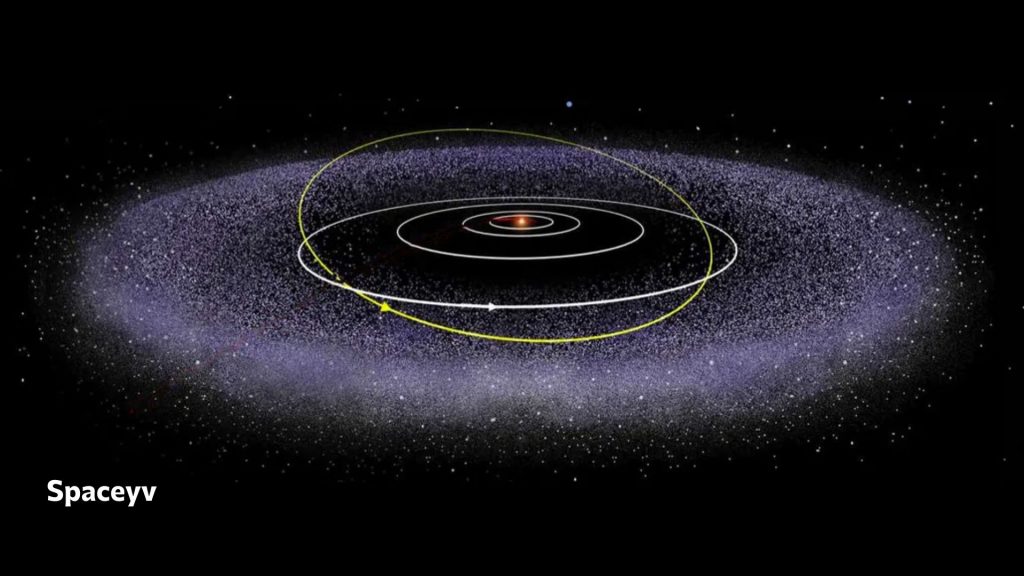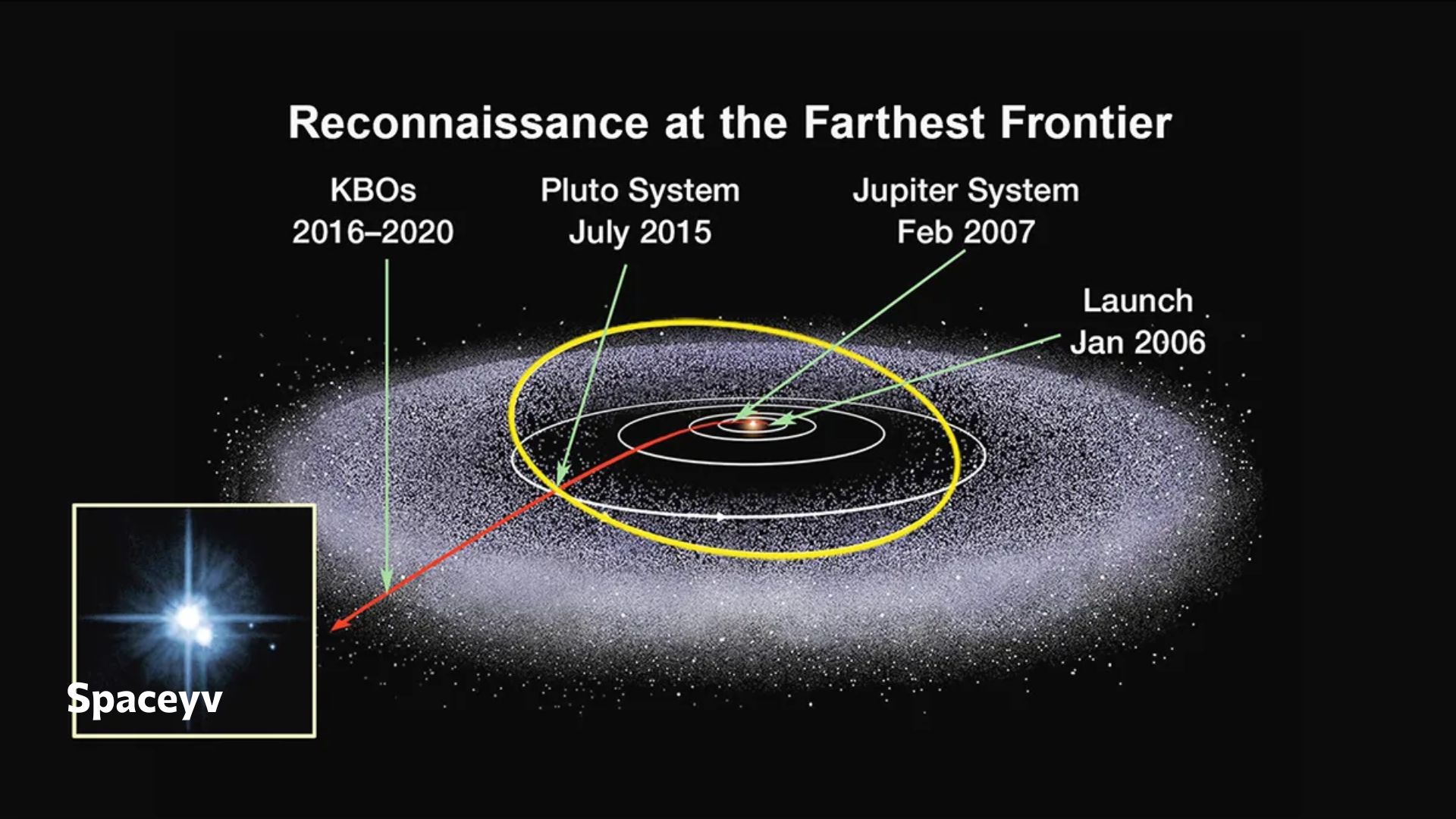The Kuiper Belt, a region of icy bodies beyond Neptune, is a fascinating and dynamic part of our solar system. In this comprehensive guide, we will delve into the characteristics, significance, and mysteries of the Kuiper Belt, shedding light on this distant realm of celestial objects. stay with Spaceyv.
What is the Kuiper Belt?
The Belt is a vast region of space located beyond the orbit of Neptune, extending from approximately 30 to 55 astronomical units (AU) from the Sun. It is similar to the asteroid belt but much larger and composed mainly of icy bodies, including dwarf planets, comets, and other small objects.
Characteristics of the Kuiper Belt:
- Composition: The Belt is predominantly composed of icy bodies, primarily made of frozen volatiles such as water, methane, and ammonia, as well as rock and dust.
- Objects: It is home to numerous objects, including dwarf planets like Pluto, Haumea, Makemake, and Eris, as well as smaller bodies known as Kuiper Belt Objects (KBOs).
- Dynamics: Objects in the orbit the Sun in a flattened disk-shaped region, with their orbits influenced by the gravitational interactions of Neptune and other large bodies in the outer solar system.

Significance of the Kuiper Belt:
- Planetary Formation: Studying the Kuiper Belt provides valuable insights into the early stages of planetary formation and the conditions present in the outer solar system during the solar system’s infancy.
- Origin of Comets: Many short-period comets originate from the Kuiper, making it a crucial source of cometary material that periodically enters the inner solar system.
- Understanding Solar System Dynamics: The Kuiper structure and composition offer clues about the migration of giant planets, the formation of the solar system, and the dynamics of small bodies in the outer regions.
The Kuiper Belt is a region of space beyond the orbit of Neptune, extending from approximately 30 to 55 astronomical units (AU) from the Sun.
Here’s a breakdown of the distances from the Kuiper to the planets in our solar system, measured in astronomical units:
- Mercury: The Kuiper is located much farther from the Sun than Mercury. Mercury orbits at an average distance of about 0.39 AU from the Sun.
- Venus: Venus is also much closer to the Sun compared to the Kuiper, with an average distance of about 0.72 AU from the Sun.
- Earth: Earth orbits at an average distance of about 1 AU from the Sun, so it is also significantly closer to the Sun compared to the Kuiper.
- Mars: Mars orbits at an average distance of about 1.52 AU from the Sun, making it closer to the Sun than the Kuiper.
- Jupiter: Jupiter is much closer to the Sun compared to the Kuiper, with an average distance of about 5.2 AU from the Sun.
- Saturn: Saturn orbits at an average distance of about 9.58 AU from the Sun, placing it much closer to the Sun than the Kuiper Belt.
- Uranus: Uranus is closer to the Sun than the Kuiper Belt, orbiting at an average distance of about 19.22 AU from the Sun.
- Neptune: Neptune, which marks the inner boundary of the Kuiper Belt, orbits at an average distance of about 30.07 AU from the Sun, making it the closest planet to the Kuiper Belt.
- Kuiper Belt: As mentioned earlier, the Kuiper Belt extends from approximately 30 to 55 AU from the Sun, with its outer edge being approximately 55 AU from the Sun.
Related Contents:
FAQs about the Kuiper Belt:
1. What is the difference between the Kuiper Belt and the asteroid belt?
- While both the Kuiper and the asteroid belt are regions of space containing numerous small bodies, they differ in composition and location. The Kuiper is located beyond Neptune and consists mainly of icy bodies, whereas the asteroid belt is situated between Mars and Jupiter and is composed primarily of rocky objects.
2. Are there any spacecraft missions to explore the Kuiper ?
- Yes, NASA’s New Horizons spacecraft conducted a flyby of Pluto and its moons in 2015, providing the first close-up images of these distant worlds. After its encounter with Pluto, New Horizons continued its journey into the Kuiper Belt, where it conducted a flyby of the Kuiper Belt Object Arrokoth in 2019.
3. How do scientists study the Kuiper from Earth?
- Scientists study the Kuiper Belt using ground-based telescopes equipped with advanced imaging and spectroscopic techniques. These telescopes can detect and characterize Kuiper Belt Objects by observing their reflected light and studying their physical properties.
4. Are there any undiscovered objects in the Kuiper Belt?
- The Kuiper is a vast and largely unexplored region of space, and it is likely that many more objects remain undiscovered. Ongoing surveys and observations continue to uncover new Kuiper Objects, contributing to our understanding of the outer solar system.
Conclusion:
The Kuiper is a dynamic and intriguing region of our solar system, offering valuable insights into planetary formation, cometary origins, and solar system dynamics. By studying the Kuiper , scientists can unravel the mysteries of our cosmic neighborhood and deepen our understanding of the universe. As exploration efforts continue, the Belt remains a frontier of discovery and scientific inquiry, holding the promise of new revelations about the nature and evolution of our solar system.



